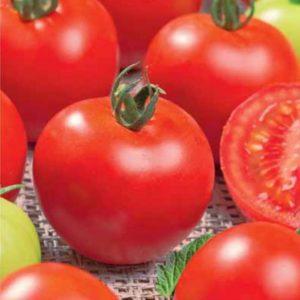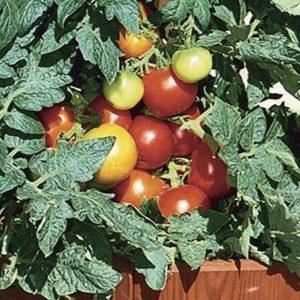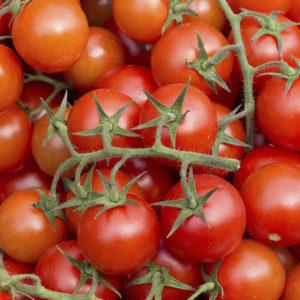Tomatoes "Little Red Riding Hood" popular among summer residents: description of the variety and instructions for growing it independently
Each owner wants his harvest to be honored with compliments, and his efforts in the beds were encouraged with good feedback. But the taste of tomatoes will depend not only on experience and talent. The right variety is half the battle.
Let's acquaint you with a find among the tomato variety - about the "Little Red Riding Hood" variety. We will tell you in detail about the features of care, share tips on how to prepare seedlings, and also share the opinion of tomato growers about "Little Red Riding Hood".
The content of the article
Description of the variety
 Tomato Red Riding Hood is one of the types of lettuce tomatoes. He comes from Germany, hence his name Rotkäppchen, which is translated from German as "little red riding hood". This variety is loved by many gardeners, as it is unpretentious in cultivation and is well suited for planting in any place.
Tomato Red Riding Hood is one of the types of lettuce tomatoes. He comes from Germany, hence his name Rotkäppchen, which is translated from German as "little red riding hood". This variety is loved by many gardeners, as it is unpretentious in cultivation and is well suited for planting in any place.
Tomato Red Riding Hood is characterized by early ripening, high resistance to diseases, unpretentious care.
Features of the variety
The name of the tomato variety does not come from the color of the fruit, but because of the peculiarity of their growth. A cluster of tomatoes forms at the top of the bush, giving the impression of a small red cap.
Plants ripen sweet fleshy fruits. This determinant tomato is characterized by an average branching of the bushes, which are about 40 cm high.
Fruit characteristics, yield
Tomatoes Red Riding Hood, rounded-flattened, with a smooth surface. The peduncle is ribbed. The surface of the fruit is smooth. The skin is thin, ripe tomatoes are red-orange. The pulp is juicy, fleshy and sweet.
This is not just an early ripening tomato, but even a super early ripening one. Sometimes it takes less than three months from germination to the first harvest. One plant can produce about 1 kg of fruit. On average, about 2-3 kg of tomatoes are obtained from one square meter.
Note. Shake the plant a little during flowering to maximize yield. This ensures better pollination.
Seedling preparation
The cultivation of the variety is best done through seedlings. Seeds begin to be planted at the end of March. If you intend to transplant seedlings in greenhouse, then sowing is best done in the last days of February.
Seed preparation
For preparation, the seeds are usually kept in a light pink solution. potassium permanganate... After that, the planting material should be germinated. This is done as follows.
Warm water is poured into a small container. The seeds are placed on a cotton napkin. After that, cover the material with a wet napkin and send it to a warm and bright place. After about two days, the seeds germinate, after which they are ready to be planted in the ground for seedlings.
Choosing a container and soil
For growing tomato seedlings, you can use both a common container and individual cassettes, cups or peat tablets.
The soil for tomato seedlings should be light, fertile. It is recommended to mix the soil with sand and peat. You can buy ready-made substrate in the store.
We proceed to sowing
In the soil, holes are made 1.5 cm deep at a distance of 3 cm. One grain is placed in each hole, sprinkled with earth and watered. The container is covered with foil and sent to a warm place.
The first shoots usually appear after 5 days, provided that the temperature regime was maintained above + 18 ° C. After the emergence of mass shoots, the film is removed, and the container is placed on the windowsill.
Seedling care
Caring for seedlings during this period consists in periodically moistening the soil, but this should be done infrequently, as the earth dries up.
Transplanting tomatoes into open ground begins only when stable warm weather is established. At night, the air temperature should not drop below +15 degrees.
Growing features
 It is advisable to send tomato seedlings Little Red Riding Hood to the area where the cabbage was harvested, peas, herbs, pumpkin, garlic or onions. Do not plant tomatoes after eggplants, potatoes, sweet peppers, corn. Choose a site that is warmed up by the sun's rays, protected from drafts.
It is advisable to send tomato seedlings Little Red Riding Hood to the area where the cabbage was harvested, peas, herbs, pumpkin, garlic or onions. Do not plant tomatoes after eggplants, potatoes, sweet peppers, corn. Choose a site that is warmed up by the sun's rays, protected from drafts.
It is better to prepare the site in the fall. They dig up the earth to a depth of 30 cm and add fertilizers, for example, humus (5 kg per 1 sq. M.), Bird droppings (1 kg per 1 sq. M.), Wood ash (100 g per 1 sq. M.). From mineral fertilizers choose potassium salt (25 g per 1 sq. M).
Landing
Before you start planting, you need to prepare the garden bed. The soil for planting tomatoes is dug up by 20-25 cm, adding humus - by 1 sq. m 0.5 buckets. Furrows are made. After that, holes are formed with a depth of about 20 cm.Further, a little warm water must be poured into each hole to moisten the soil.
The seedlings are carefully placed in the hole and covered with earth, carefully tamped. Water the plants again the next day. Further, the seedlings must acclimatize and take root. During this period, they need good watering.
Follow-up care
Caring for these tomatoes does not require any special skills. It comes down to timely watering, as well as loosening and mulching the soil surface. Freshly cut grass, straw, or young weeds can be used as mulch.
Top dressing plants should be started a week after the seedlings have taken root. For this, foliar fertilizers (urea solution, boric acid, potassium monophosphate) are suitable.
Since the bush is short and compact (it reaches a height of about 40 cm), this variety does not need tying... You can also refrain from forming a bush and pinching. Thanks to these qualities, the variety is great for summer residents who cannot pay much attention to caring for plants.
What to look for
 Since Little Red Riding Hood tomatoes are unpretentious, caring for them will not cause much trouble.
Since Little Red Riding Hood tomatoes are unpretentious, caring for them will not cause much trouble.
Water the plants abundantly, but not too often. Watering frequency depends on air and soil moisture. It is optimal to wait until the soil dries up.
You need to pour water strictly at the root. When the first color appears, the intensity glaze worth reducing. If you don't follow this advice, you run the risk of getting a watery and tasteless crop.
Since Little Red Riding Hood tomatoes love oxygen-rich soil, the soil must be loosened from time to time... But this should be done only superficially, so as not to harm the root system of plants.
Diseases and pests
Little Red Riding Hood tomatoes are disease-resistant and pests... But sometimes they can infect this variety too. We will briefly describe the main problems that a gardener may encounter when planting this variety of tomatoes on his plot.
One of the diseases that can threaten tomatoes is late blight. It is necessary to remove the leaves affected by the disease, and the plant itself should be treated with preparations containing copper, for example, copper sulfate.
Certain insects can also threaten your crops, for example:
- spider mite. It is a small spider, its color varies from green to brownish-brown, hiding most often on the back of the leaf. It feeds on the sap of green plants, leaving behind dry skeletons entwined with cobwebs;
- thrips. These are small oblong beetles of black, gray and brown colors. The size depends on the species and ranges from 0.5 mm to 1.5 cm. They dehydrate leaves, flowers and fruits, and also pollute them with secretions;
- whitefly. It is a small butterfly that does significant harm to the plant. Both the larvae and the adult use plant sap as food, sucking it out of plant tissues;
- aphid. This parasite feeds on plant juices, drying them up and leading to death.
Herbal preparations can be used to combat them. For example, for spraying, you can use an infusion of celandine. It is prepared as follows: 0.8 kg of fresh green mass of celandine (or 0.2 kg of dry grass) is infused for 12 hours in 10 liters of water. Warm soapy water will also help get rid of aphids. The solution should be sprayed on all parts of the plant, especially paying attention to places where insects accumulate. In extreme cases, insecticides will help get rid of pests.
Important! It is forbidden to use insecticides after the fruits are set.
We grow tomatoes in an open garden and in a greenhouse
 Tomatoes of this variety are picky. In greenhouse conditions and outdoors, they require almost identical maintenance. There are several nuances worth paying attention to.
Tomatoes of this variety are picky. In greenhouse conditions and outdoors, they require almost identical maintenance. There are several nuances worth paying attention to.
Depending on the further "habitat" of the bush, planting dates differ. Seedlings are transplanted into the greenhouse, starting in mid-May, on an open bed - in early June.
In the garden, Red Riding Hood tomatoes are best placed near the following crops: parsley, zucchini, cauliflower, dill, cucumbers, or carrots. It is this neighborhood that will be ideal. It is important not to plant these tomatoes where potatoes, eggplants or bell peppers have previously grown.
It should be noted that pests threaten the plant in the greenhouse more often.
Another fact about these tomatoes will delight gardeners: the plant is suitable for planting not only in greenhouses, but also at home on a balcony or windowsill. Due to its compactness and unpretentiousness, the bush grows and bears fruit even in adverse conditions.
Harvesting and application of the crop
In the photo - a tomato Red Riding Hood.
 The first harvest of tomatoes Red Riding Hood is harvested within 95-100 days after planting. Fruit sizes are small but even. The vegetables are round and neat. Ripe fruits have a rich and deep bright red hue. Sometimes it even looks orange.
The first harvest of tomatoes Red Riding Hood is harvested within 95-100 days after planting. Fruit sizes are small but even. The vegetables are round and neat. Ripe fruits have a rich and deep bright red hue. Sometimes it even looks orange.
Since the skins of Red Riding Hood tomatoes are delicate and thin, these tomatoes are not suitable for transportation.
Most often they are consumed fresh. Red Riding Hood tomatoes are considered salad tomatoes, but are suitable for making soups, sauces, mashed potatoes, and juices. This variety is also used for canning.
Advantages and disadvantages of the variety
Having studied the "Little Red Riding Hood" tomato variety, let's briefly dwell on its advantages and disadvantages.
So, the "pluses" include:
- resistance to temperature extremes;
- compactness; plant, does not require extra space;
- resistance to diseases typical for tomatoes;
- pinching bushes can be omitted;
- taste of fruits;
- behave well both in the open field and in the greenhouse;
- early maturation;
- minimal care, excellent response to feed formulations.
From the negative, it can be noted that they:
- not subject to long-term storage;
- do not tolerate transportation well.
Farmers reviews
If you have any doubts, check out the opinions of those who have already practiced growing these tomatoes.
- Oleg, 39 years old, Kuban. “I really enjoy growing Little Red Riding Hood. For the third year I have it on my site. I like to pickle. The whole family is delighted with my pickles. They look super appetizing in the bank. "
- Sergey 49 years old, Chelyabinsk. “The variety fully met expectations - what was stated on the package, and it happened. The bushes are small, the fruits, by the way, are also slightly larger than Cherry. But the bushes were sprinkled with small tomatoes.I will plant in the future, as we have successfully stood the winter in banks, none of them has grown cloudy. "
- Olga, 59 years old, Murmansk. “This is the first time I planted something on the balcony, but I'm glad I chose Little Red Riding Hood on the advice. I planted a seed for testing in an ordinary flower pot. A small bush grew like a decorative one, but as a result it was completely covered with tomatoes. "
Conclusion
Red Riding Hood tomatoes are able to please summer residents. After all, the preparation of seedlings and the subsequent care of the plant does not require special skills, and because of the resistance to diseases and pests, each gardener can be calm about his harvest. But the harvest will be not only tasty, but also rich.